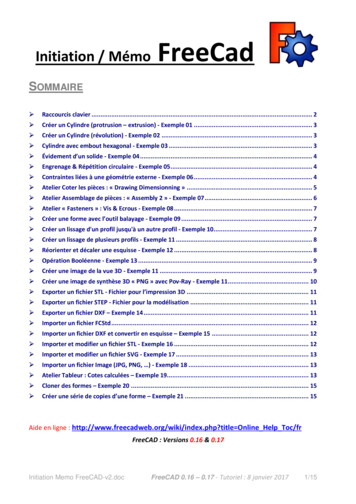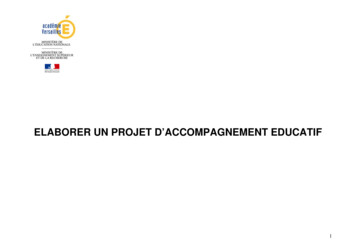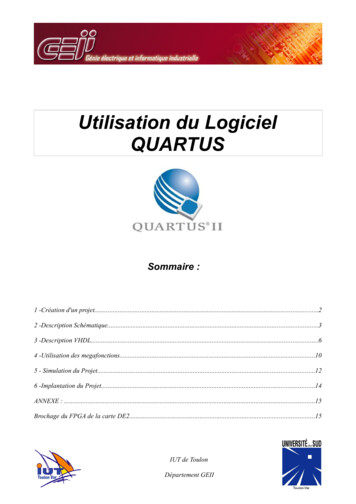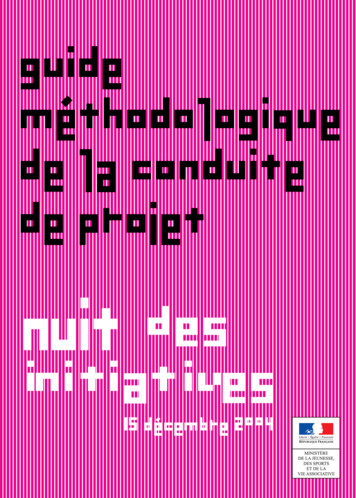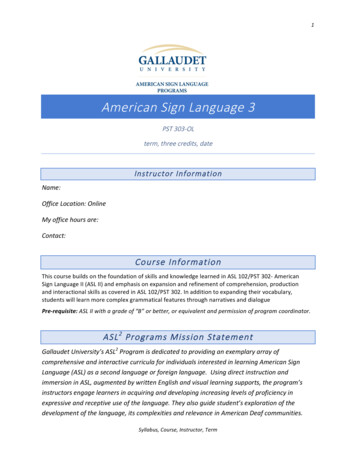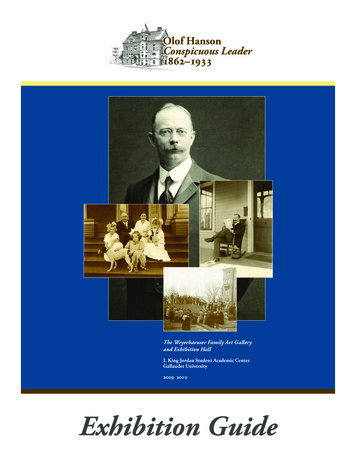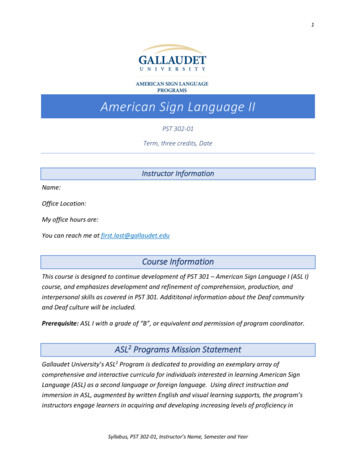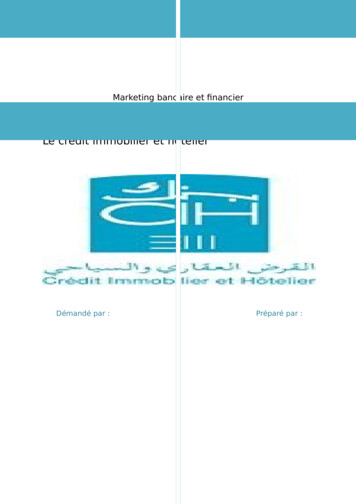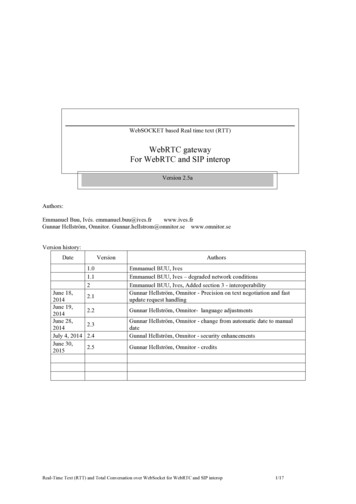
Transcription
WebSOCKET based Real time text (RTT)WebRTC gatewayFor WebRTC and SIP interopVersion 2.5aProjet SécuritasAuthors:Emmanuel Buu, Ivés. emmanuel.buu@ives.frwww.ives.frGunnar Hellström, Omnitor. Gunnar.hellstrom@omnitor.se www.omnitor.seVersion history:DateVersion1.01.12June 18,2014June 19,2014June 28,2014July 4, 2014June 30,20152.12.2AuthorsEmmanuel BUU, IvesEmmanuel BUU, Ives – degraded network conditionsEmmanuel BUU, Ives, Added section 3 - interoperabilityGunnar Hellström, Omnitor - Precision on text negotiation and fastupdate request handlingGunnar Hellström, Omnitor- language adjustments2.4Gunnar Hellström, Omnitor - change from automatic date to manualdateGunnal Hellström, Omnitor - security enhancements2.5Gunnar Hellström, Omnitor - credits2.3Real-Time Text (RTT) and Total Conversation over WebSocket for WebRTC and SIP interop1/17
ContentsWebSOCKET based Real time text (RTT) . 1Contents . 21 Overview . 31.1 Purpose of this document . 31.2 Acknowledgement . 32 WebRTC based total conversation . 52.1 Signalling . 52.2 Real-time text over websocket . 52.3 Offer / answer model . 62.3.1 Negociating real-time text . 62.3.2 Conversation with multiple text streams . 82.3.3 Handling audio and video streams . 82.4 Security . 83 Interoperability with regular SIP clients . 93.1 Principle of interoperability between WebRTC based and SIP based TC clients . 93.2 Interoperability requirements for the SIP server . 103.3 Interoperability requirements for the Media Proxy . 103.4 Call procedures for acheiving interoperability . 113.4.1 Call procedure A : no prior client type detection. 113.4.2 Variant of call procedure A . 123.4.3 Call procedure B with client type detection. 133.5 Specific procedures for media interoperability . 133.5.1 Support of RTCP FIR and RFC 5168 . 133.5.2 Double offering for text media in call procedure A. 144 Implementation choices and uses cases. 164.1 Actors. 164.2 Details of sip server . 164.3 Features supported . 174.4 Use cases. 184.4.1 WebRTC to WebRTC call . 184.4.2 WebRTC to SIP call . 194.4.3 SIP client busy . 205 References . 21Real-Time Text (RTT) and Total Conversation over WebSocket for WebRTC and SIP interop2/17
1OverviewIVeS is building a WebRTC gateway as part of a project with Omnitor. One of the goal of this project is toprovide Total Conversation using a WebRTC client and enable to interoperate with regular SIP based TotalConversation clients.Total Conversation as implemented in the regular SIP world enable the use of any combination of audio, videoand Real-Time Text (RTT) media. In regular SIP, RTP is used to carry all media. Real-time text is based onT.140 packetized over RTP using RFC 4103. RFC 2198 redundancy is used to achieve reliability.WebRTC is an HTML5 standard that enables real-time communication using standard browser features. Thesupported media are audio and video. The current implementation of WebRTC uses audio and video codecs thatare not generally supported in the sip world: VP8 for video and OPUS for audio.The WebRTC standard provides a data exchange mechanism called “data channel” that is not yet ready forproduction, especially regarding NAT traversal issues.1.1Purpose of this documentThe present document proposes a way to carry real-time text over Websocket and negotiate it over SIP in aninteroperable manner. The mechanism is implemented in a system for WebRTC based RTT and TotalConversation, with interoperability with traditional SIP.The system is implemented by Ivés and Omnitor in a project called RERC-Telecommunications Access.The specification is made so that it shall be simple to replace the Websocket mechanism for RTT with aWebRTC data channel based mechanism when the WebRTC data channel specifications and implementationsare mature.Section 2 proposes a real-time text transport mechanism from a general point of view.Section 3 proposes an interoperability mechanism between WebRTC total conversation and SIP based totalconversation.Section 4 select implementation choices and limits for the current project.1.2AcknowledgementThe contents of this resource were developed in part with funding from the National Institute onDisability, Independent Living, and Rehabilitation Research (NIDILRR grants # H133E040013, &90RE5003-01-00) in the Administration for Community Living (ACL), Department of Health andHuman Services (HHS). The contents do not necessarily represent the policy nor endorsment ofNIDILRR, ACL, or HHS.Real-Time Text (RTT) and Total Conversation over WebSocket for WebRTC and SIP interop3/17
22.1WebRTC based total conversationSignallingIn order to enhance interoperability with regular SIP client, some restructuring and practices are proposed forusing WebRTC technologyWebRTC based total conversation clients shall use the SIP protocol as signalling and comply with RFC3261. Support for Websocket and Websocket over TLS based transports as specified by RFC 7118 ismandatory. UDP and TCP transport are not supported.As Web browsers do not implement server mode, we mandate the use of a SIP server.WebRTC based total conversation clients must register on a SIP server. The registration process start byestablishing a Websocket connection with the server and then continues by performing a SIPregistration as specified by RFC 3261.WebRTC based total conversation clients must maintain the Websocket connection open permanentlyuntil the user decides to close it and unregister.The SIP server shall always reuse an open Websocket connection and never attempt to open aWebsocket connection to the client.If the Websocket connection disconnects, the client shall attempt a new connection and refresh itsregistration by sending a new REGISTER message and increment Cseq field.2.2Real-time text over websocketAs WebRTC implementations does not support real-time text over RTP, we propose to use Websocket astransport for real-time text. Websocket over TLS can be used to secure cipher the text communications over theopen Internet.The total conversation clients shall negotiate real-time text as specified in the next section. If both clientsupport real-time text, they will obtain an URI of a websocket connection to a media proxy.Both clients shall then open a websocket connection to the media proxy. Real-time text is the exchanged overthese connections as T.140 payload. A transmission interval of 300 ms is recommended.No redundancy mechanism is necessary as Websocket is a reliable transport. However, network conditions maydegrade and cause a websocket connection to disconnect or block.SIP over WSWebRTCclientT.140 over WSSIP serverMediaproxySIP over WST.140 over WSWebRTCclientBridgeIn case of disconnect, the media proxy shall insert in the T.140 stream one Unicode Replacement Character tonotify the other leg of the stream interruption.If the websocket is blocked, the media proxy will fail to push the T.140 stream into it. In case the media proxyReal-Time Text (RTT) and Total Conversation over WebSocket for WebRTC and SIP interop4/17
fails or blocks sending T.140 data into this connection, it shall disconnect the websocket and insert aReplacement Character into the other websocket to indicate a possible loss of data.In the case that the Websocket connection for real-time text is broken, the client shall make an effort to reestablish a Websocket connection using the same URL. If it cannot be deducted that text was not lost orduplicated because of the broken and reestablished connection, the Unicode Replacement Character shall beinserted by both the client and the server in the received text at the point where text may have been lost orduplicated because of the broken and reestablished connection. If reestablishment is not successful, theReplacement Character shall also be inserted as a marker for a possible character loss.2.3Offer / answer modelWhen establishing a call, a WebRTC based total conversation client shall comply with RFC 3264.2.3.1Negociating REAL-TIME textA WebRTC based total conversation client shall add an additional media stream compliant with RFC 4145 to theoffer, generated by the WebRTC API:m text 54321 TCP/WS t140c IN IP4 192.0.2.1a setup:activea connection:newa sendrecvIt indicates to the media proxy that the WebRTC client is ready to offer text over Websocket using T140 formatand it will initiate the Websocket connection. The port and the IP address mentioned here are meaningless.The SIP server shall interpret this media stream definition and contact one or several media proxies and preparea text session. The communication between the SIP server and the media proxy is not part of this specification.If the client requests secure Websocket, the offer should include TCP/WSS instead of TCP/WS.When forwarding the message to the callee, the SIP server shall change the media description of the offer asfollow:m text port TCP/WS t140c IN IP4 mediaproxy address a setup:passivea connection:newa sendrecva ws://mediaproxy:port/rest/of/urlWhere mediaproxy address is the hostname or the IP address of the mediaproxy. It is ignored by the client. port is the port the of the websocket server (ignored by the called client too)The SIP server shall insert one SDP attribute « a ws » (or a wss, if secure WebSocket is requested) that is theURL of the Websocket connection to reach the media proxy.When receiving this offer the called client shall open an websocket connection to the media proxy using theURL specified by the attribute « a ws ». It shall answer as follow :Real-Time Text (RTT) and Total Conversation over WebSocket for WebRTC and SIP interop5/17
m text 54321 TCP/WS t140c IN IP4 192.0.2.2a setup:activea connection:newa sendrecvThe SIP proxy shall generate a new Websocket URL and rewrite the answer as followm text port TCP/WS t140c IN IP4 mediaproxy address a setup:passivea connection:newa sendrecva ws://mediaproxy:port/rest/of/otherurlWhen receiving this answer the caller client shall open its Websocket for real-time text. Once the call isestablished, both clients may exchange real-time text by sending and receiving T.140 data over their respectiveWebsocket connection.If the called client does not support real-time text or is not willing to use this media for the conversation, itshould disable the media altogether by sending an « m » line with the port value set to zero in the SDP answer.m text 0 TCP/WS t1402.3.2Conversation with multiple text streamsIn some situation (conferences, subtitle in several langages), it is desirable to establish several text stream in asingle conversation.To be completed.2.3.3Handling audio and video streamsWebRTC clients mandate the use of ICE and TURN for NAT traversal for audio and video streams. Severaloptions can be implemented:Option 1 : add a TURN server in the ICE candidatesWhen two WebRTC client call each other, the SIP server may add in the ICE candidate list of SDP offer and ofthe SDP answer, the address of a TURN server. This candidate shall have a low priority to encourageestablishment of peer to peer media stream communications.Option 2 : act as media proxyIn this case, the SIP server specifies one single media proxy as ICE candidate in offers and answers to forcemedia to be processed by a media proxy.2.4SecurityIn order to enforce conversation confidentiality, it is recommended to use WebSocket over TLS for both SIPsignalling and text media.It is expected that the WebSocket URL contains a one time token valid during the call to avoid outsider toconnect to the Websocket server and interfere with the conversation.It is also expected that the media proxy accepts only one connection per URL.Real-Time Text (RTT) and Total Conversation over WebSocket for WebRTC and SIP interop6/17
3Interoperability with regular SIP clientsOne of the purposes of Total Conversation is to provide interoperability. This section extends the requirementsdescribed in section two in order to enable interoperability between WebRTC based total conversation clientsand SIP based total conversation client. It also propose some call procedures to achieve call interoperability.3.1Principle of interoperability between WebRTC based and SIP based TC clientsHaving selected a common signaling protocol for both type of client enables a natural interoperability atsignaling level. But in order to achieve call interoperability, the media level needs to interoperate. The followingissues needs to be addressed: There is often no common video codecs between SIP client and WebRTC client as current WebRTCimplementations does not support H.264 and few SIP based total conversation clients support VP8.SRTP-DTLS is not supported by most SIP clients and we cannot expect a wide adoption soon.WebRTC mandate the support of ICE, RTCP feedback and a clever congestion control algorithm,RTCP multiplexing and so on. Interaction between a WebRTC client and a client that do not supportthese extension is unspecified.WebRTC favor a new audio codec called OPUS that is not widely supported. Falling back to G.711 isallowed but degrades the audio quality significantly.WebRTC real-time text as specified in section 2 does not interoperate naturally with real-time texton RTP transport as specified in RFC 4103.The designers of WebRTC brought a lot of needed improvement on media transport but did not specifyinteroperability with legacy systems. In order to achieve this interoperability, several principles are possible: When a WebRTC and a legacy SIP client interoperates, the media proxy need to process the media anddecapsulate it, and perform the necessary audio and video transcoding The SIP server should be aware of the nature of both client at each side of the conversation and mayengage or not media proxy if both client use the same technology. The criteria used to discriminate a WebRTC client from a SIP client is the transport of the SIP protocol.Use of WebSocket means WebRTC client.Technology/media featureWebRTC clientSIP clientH.264 video codecMay support, will be offered.Supported.VP8 video codecSupportedMay support, will be offered.OPUS audio codecSupportedMay support, will be offeredSRTP-DTLSSupportedNot supportedRTCP FeedbackSupportedMay support, will be offeredICESupportedMay support but will NOT beofferedReal-time textAddition specified in section 2 May support RTT over RTP(RFC 4103), will be offeredReal-Time Text (RTT) and Total Conversation over WebSocket for WebRTC and SIP interop7/17
Table showing the support of media and features in the two types of clients involved. “May support” means thatthe gateway supports the feature, and it depends on the selected client if the support is used.This conversion and support requires a SIP server and a media proxy to comply with additional requirementslisted in the next sections.3.2Interoperability requirements for the SIP serverThe SIP server shall support SIP as described in RFC 3261, including UDP and TCP transport for SIP. The SIPserver shall act as proxy and registrar as seen by the client1.3.3Interoperability requirements for the Media ProxyThe Media proxy shall be able to handle SRTP-DTLS, act as an ICE candidate and decode the audio and videomedia streams from client.The Media proxy shall be able to handle video stream transcoding from H.264 to VP8 and vice and versa.The Media proxy shall support RTCP feedback, especially nack and fir as well as Audio Redundancy payloadand Forward Error Correction used by some WebRTC implementationsThe media proxy should support tmmbr and goog-remb messages, and implement congestion control algorithmas specified by rtcweb-congestion/ and known as « zero artefact »The media proxy should be able to transcode from OPUS codec to G.722 or G.722.1 codec in order to preservethe high quality audio brought by WebRTC and interoperate with SIP client thatThe media proxy shall be able to process real-time text both as specified in section 2 and as specified in RFC4103. The media proxy shall be able to translate between the two modes.3.4Call procedures for acheiving interoperabilityThree possible strategies can be implemented by the SIP server to provide interoperability with regular totalconversation SIP client.For clarity of explanation, let us assume that WebRTC client « Alice » calls SIP based client « Bob ».3.4.1Call procedure A : no prior client type detectionStep 1 - Alice calls. The INVITE packet comes to the SIP server. Because the contact contains a SIP uri with« transport ws », the SIP server infers that « Alice » is using a WebRTC client.The SDP contains : OPUS, G.711 codecs for audio, VP8 for video. T.140 over WebSocket as real-time text.Step 2 – The SIP proxy contacts a media proxyIt modifies the INVITE packet as follow : 1It sets the media proxy address as the only ICE candidate.It adds H.264 as supported video codecIt adds G.722 supported codec.If text media is requested by Alice, it adds a second text media with RTP using SAVPF support (seesection )It keeps all RTCP feedback and cryptology attributes.Here the SIP server is a logical entity rather than a physical system. It may be composed of a separate proxyand registrar but it has to provide these two functions.Real-Time Text (RTT) and Total Conversation over WebSocket for WebRTC and SIP interop8/17
Step 3 – Bob's client receives the INVITE packetAs it is a well behaved client, it does not support « RTP/SAVPF » profile nor the « TCP/WS » profile and rejectsthe call with 488 Not Accepted Here as no media can be negotiated.Step 4 – The SIP server process the 488 response and reissue a new INVITE packet (with increased Cseq) and anew SDP that uses media with « RTP/AVP » profile only. Crypto attribute and ICE attributes are removed.RTCP feedback attributes are kept.The SIP server knows the « Bob » is a SIP client.Step 5 - « Bob » receive the new INVITE and answer the call with 200 OK.It select H.264 ang G.722 as audio and video codecs. It select T.140 with redundancy level 3 for real-time text.Step 6 – SIP server processes the answerIt engages the transcoders and modify the SDP as follow It select VP8 as video codecIt select OPUS as audio codecIt answer to real-timetext over websocket.It adds ICE candidate for the mediaproxyit adds DTLS crypto attribute for the media proxyThe answer is then sent to Alice.Step 7 - Alice receives the 200 OK answerIt processes it and establish the media streams with the media proxy.It sends the ACK message that starts the transcodersThe ACK message is forwarded to Bob that start sending and receiving transcoded media from and to the mediaproxy.The limitation of this procedure is : We cannot assume that all SIP clients will behave as described above even if the 488 answer is the mostlogical answer to expect in that case.It adds a message exchange and make the call connection a bit longer.We also note that the step 4 of this procedure requires the SIP server to act as back to back user agent (B2BUA).3.4.2Variant of call procedure AIn order to overcome the first issue in the previous procedure, we may – in step 3, sends an INVITE with a« non-WebRTC » SDP. Then we would make sure that WebRTC clients answers 488 in this case.This is possible as this project provides its own WebRTC client. However it does not accommodate futureWebRTC clients.3.4.3Call procedure B with client type detectionAs the SIP server act as registrar, it stores the contact of each client and is therefore able to know which type ofclient it needs to reach. Even if we consider cases when the SIP server needs to forward calls to an ACD oranother server, it can safely assume that those servers are « SIP clients ». In that case, the SIP server can directlycreate the « right » SDP suited for the client type.Real-Time Text (RTT) and Total Conversation over WebSocket for WebRTC and SIP interop9/17
The SIP server itself may not be a single physical entity.Here is an example of distributed SIP infrastructure that may act as a SIP server.RegistrarProxy 1B2UBAProxy 2AliceBobMediaproxyIn the diagram above, the subsystem that is aware of the nature of Bob is the registrar. The subsystem that is ableto execute the core of the call procedure is the B2BUA. The call procedure needs to be augmented as follow:When the B2BUA needs to identify the type of client in order to generate the appropriate SDP, 3.5It should query the registrar with an OPTIONS bob@registrar message. The registrar may answer directly and specify the contacts of the client The registrar may forward the OPTIONS message to the client and relay the answer to the B2BUA In both cases, by examining the contact, the B2BUA will be able to decide which SDP to use.It may forward the call to the registrar. In that case, it is expected that the registrar replies « 488 notacceptable here » if the SDP of the call does not match the type of client.Specific procedures for media interoperability3.5.1Support of RTCP FIR and RFC 5168Some older SIP clients do not support RTCP Picture Loss Indicator or Fast Intraframe Request. Well behavedSIP that support those messages should indicate it in the SDP using « rtcp-fb » attributes.When SIP server and the media proxy connect a WebRTC client Alice with a SIP client Bob that do not supportRTCP FIR,Case 1 : there are no video transcoder engaged Upon receiving either RTCP FIR, the media server shall process it and generate a new intraframe.Upon receving a Fast Update Request as specified in RFC 5168, the SIP server should contact themedia proxy. The later shoud generate an intraframe.Case 2 : there are video transcoders engagedMedia proxy and SIP server should 3.5.2Translate RTCP FIR into Fast Update Request as specified in RFC 5168Translate Fast Update Request as specified in RFC 5168 into RTCP FIRDouble offering for text media in call procedure AIn the step 2 of call procedure A, if text needs to benegotiated, the new SDP shall include two « text » mediaReal-Time Text (RTT) and Total Conversation over WebSocket for WebRTC and SIP interop10/17
in the offering. One with RTP/SAVPF transport, one with TCP/WS transport. This is needed as the SIP serverdoes not know which kind of client is being called.This is done by defining an SDP media group FID according to RFC 5888a group:FID textoverws textrfc4103( )m text ws port TCP/WS t140c IN IP4 mediaproxy address a setup:passivea connection:newa sendrecva ws://mediaproxy:port/rest/of/otherurla mid:textoverwsm text rtp port SAVPF 102 101a fingerprint:.a setup:passivea connection:newa sendrecva ws://mediaproxy:port/rest/of/otherurla mid:textrfc4103a rtpmap:102 REDa rtpmap:101 T140a fmtp:102 101/101/101A well behaved SIP client should select the media that it can process and reject the others by answering with an« m » line with port 0.Real-Time Text (RTT) and Total Conversation over WebSocket for WebRTC and SIP interop11/17
4Implementation choices and uses casesThis chapter describes the implementation by Ivés and Omnitor of the principles specified in the previouschapters.4.1ActorsWebRTC client1WebRTC client1 is made of Mobicent HTML5 WebRTC client (with some corrections), run on Chrome(add version).WebRTC client2WebRTC client2 is the same software except it is run on Firefox web brower.Regular SIP clientRegular SIP client with total conversation (Video, RTT and audio ) supportSIP serverSee next section4.2Details of sip serverMediaproxyXMLRPCB2UBASIPSIPKamailio(acts as proxy and al-Time Text (RTT) and Total Conversation over WebSocket for WebRTC and SIP interop12/17
4.3Features supportedFeatureAudio codecs supportedG.711, Speex, OPUS, G.722Video codec supportedH.263, H.264, VP8RTCP FeedbackFIR, TNMBR, NACK, GOOGLE-REMBZero artefact supportYesDTLS-SRTPYesReal-time textT.140 over RTP (RFC4103) and T.140 over WSCall procedure selectedCall procedure BLimitations (that can be reduced later) Behavior in case of multiple registrations is undefined.Full implementation of re-INVITE / UPDATE will be gradual.First release of GW will not provide the ability to use peer to peer media.Gateway will not support media bundling as me Text (RTT) and Total Conversation over WebSocket for WebRTC and SIP interop13/17
4.44.4.1Use casesWebRTC to WebRTC callReal-Time Text (RTT) and Total Conversation over WebSocket for WebRTC and SIP interop14/17
4.4.2WebRTC to SIP call4.4.3SIP client busyReal-Time Text (RTT) and Total Conversation over WebSocket for WebRTC and SIP interop15/17
SIP call to WebRTCSIP to WebRTC callsSIP client busyLate offer / late answerReal-Time Text (RTT) and Total Conversation over WebSocket for WebRTC and SIP interop16/17
5ReferencesT.140 ITU-T T.140RFC 4103RFC 7118RFC 3261RFC 4467RFC 4566RFC 5888Real-Time Text (RTT) and Total Conversation over WebSocket for WebRTC and SIP interop17/17
Real-Time Text (RTT) and Total Conversation over WebSocket for WebRTC and SIP interop 3/17 1 Overview IVeS is building a WebRTC gateway as part of a project with Omnitor. One of the goal of this project is to provide Total Conversation using a WebRTC client and enable to interoperate with regular SIP based Total Conversation clients.
